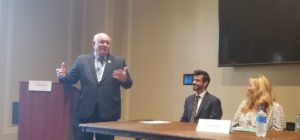CTE without borders allows learners to engage in learning opportunities of their choosing regardless of their locality. Learners have the flexibility and support to engage in learning opportunities no matter where they live and no matter whether they are engaging in online or hybrid learning or attending courses and programs on school campuses outside of their home districts or local institutions.
CTE without borders calls attention to the geographic dimension of equity and the disparities among learners related to access to high-quality programs that can prepare them for the workforce. Often, learners are excluded from enriching CTE programs and work-based learning opportunities due to geographic barriers.1 This issue is most common for learners in rural locations but is also experienced in suburban and metropolitan areas. To ensure that the CTE community remains flexible to meet the needs of learners and industry across the country, leaders should enable their CTE systems to provide expanded access to high-quality CTE programs and work-based learning opportunities.
The second release of Advance CTE’s new resource, the CTE Without Borders Policy Playbook, highlights the infrastructure that should be established to expand access to high-quality CTE and work-based learning opportunities and ways leaders can remove barriers to ensure learners and families are informed and supported in expanded access within and across states. This final release in the series articulates the remaining four of six focus areas critical to expanding access to high-quality CTE and work-based learning:
- Incentivizing Access With Flexible and Sustainable Funding;
- Capturing Learners’ Credits, Credentials and Experiences;
- Optimizing the Conditions for Virtual and Hybrid Learning Opportunities; and
- Informing and Supporting Learners and Families.
State CTE leaders can learn how to build the infrastructure to expand learners’ access to high-quality CTE and work-based learning opportunities and consider strategies that remove barriers to support learners as they navigate through their CTE programs.
This final release features promising state and local practices from across the country including Georgia, Kentucky, Ohio, Wyoming and more; strategies to actualize each focus area; and resources to support state and local leaders in providing expanded access within and across states.
Visit the Learning that Works Resource Center to read the final release in the series and for additional resources to support CTE Without Borders.
Haley Wing, Senior Policy Associate



 In March 2021, Advance CTE released
In March 2021, Advance CTE released  What can state leaders do to expand access to high-quality career technical education (CTE) in rural communities? That was the focus of an event held last Thursday by the Congressional CTE Caucus, in coordination with Advance CTE.
What can state leaders do to expand access to high-quality career technical education (CTE) in rural communities? That was the focus of an event held last Thursday by the Congressional CTE Caucus, in coordination with Advance CTE.  How can state and local leaders tackle these challenges? During the event, Dr. Marcie Mack — state CTE director for Oklahoma, spoke about
How can state and local leaders tackle these challenges? During the event, Dr. Marcie Mack — state CTE director for Oklahoma, spoke about  Jan Hanlon, executive director for the Mountain State Education Service Cooperative, discussed how West Virginia is tackling access challenges through Simulated Workplace programs. Through Simulated Workplace, more than
Jan Hanlon, executive director for the Mountain State Education Service Cooperative, discussed how West Virginia is tackling access challenges through Simulated Workplace programs. Through Simulated Workplace, more than Livingston, Montana is a small ranching community of about 7,000, just north of Yellowstone National Park. Most of the town’s economic activity revolves around agriculture and tourism — being so close to Yellowstone brings in lots of travelers. Bozeman, which is about 30 miles away hosts a growing manufacturing and photonics industry. Despite these opportunities, students at nearby Park High School don’t always interact with industry leaders in the area, limiting their ability to explore different career options and weakening the talent pool for local business owners.
Livingston, Montana is a small ranching community of about 7,000, just north of Yellowstone National Park. Most of the town’s economic activity revolves around agriculture and tourism — being so close to Yellowstone brings in lots of travelers. Bozeman, which is about 30 miles away hosts a growing manufacturing and photonics industry. Despite these opportunities, students at nearby Park High School don’t always interact with industry leaders in the area, limiting their ability to explore different career options and weakening the talent pool for local business owners. In Nebraska, rural districts have been undertaking a wholesale needs assessment of local Career Technical Education (CTE) program offerings under the state’s reVISION initiative. Under reVISION, school and district leaders examine regional labor market data and hear from local employers to determine whether or not the programs available to students are those that are most in-demand.
In Nebraska, rural districts have been undertaking a wholesale needs assessment of local Career Technical Education (CTE) program offerings under the state’s reVISION initiative. Under reVISION, school and district leaders examine regional labor market data and hear from local employers to determine whether or not the programs available to students are those that are most in-demand. 
